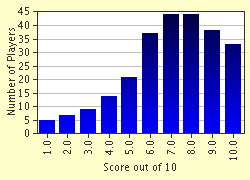Quiz Answer Key and Fun Facts
1. In 1888, in the very city where the legendary Candy Cummings had invented the curveball, there were seven weddings, weddings that would loom large in one of sports most storied franchises. For in 1890, these seven relative newlywed men and their team would leave the less highly regarded American Association to join the National League. Under what name did this team that would ultimately become the Dodgers play in 1890?
2. In 1911, the team adopted a new name, a name that reflected life in American cities in the early 20th century. What kind of "dodgers" did the team become in 1911?
3. In 1934, the Giant's manager was asked about the Brooklyn Dodger's prospects and replied, "Haven't heard a peep from there, is Brooklyn still in the league?" This insult is credited with triggering all of the following except for what?
4. In 1937, the Dodgers received their unofficial nickname of "bums". Very appropriately, a cabby inspired this turn of events when he inquired of his passenger, "So how did those bums do today?" What was the occupation of the passenger, Willard Mullin, who was responsible for publicizing the name "bums"?
5. In 1937, the Dodgers finished 33 games out of first place. Some might say that it was with the hiring of a new manager in 1939 that the bums of summer became "The Boys of Summer". Who was hired to manage the Dodgers in 1939 (Hint: he later became a third base coach for the team)?
6. The year 1947 was a banner year for the Dodgers, easing some of the futility of the previous 25 years in which they had won only two pennants and not one World Series. Which of the following did the Dodgers do in 1947?
7. On August 11, 1951, the Dodgers led the National league by 13 games. However, when the season ended they found themselves tied and in a three-game playoff with the Giants. Ahead 4-1 in the bottom of the ninth, how did Dodger reliever Ralph Branca end the inning?
8. Walter O'Malley had become the controlling owner and team president in 1950. In 1954, he shocked many when he hired "Walter Who" to manage the team. What was the last name of this "quiet man" with whom Walter O'Malley would sign 23 consecutive one-year contracts?
9. As the 1955 season began, the Yankees had won 16 World Series, the Giants five, the Dodgers zero. Which of the following events occurred in this landmark season?
10. Even the best exertions of the mighty O'Malley, he could not secure for our beloved Dodger heroes, the stadium they so richly deserved in Brooklyn. Even after the Dodgers vanquished their nemesis the Yankees in the World Series, even when shown plans for baseball's first domed stadium, the powerful Lords of Brooklyn remained intent on keeping our boys imprisoned in dilapidated Ebbet's Field. But on May 2, 1957, flying in a police helicopter through the sunny Southern California skies, the astute O'Malley descried the key to his team's future, Chavez Ravine. According to his online biography, which feature of the geography did Walter O'Malley find particularly impressive?
Source: Author
uglybird
This quiz was reviewed by FunTrivia editor
Nightmare before going online.
Any errors found in FunTrivia content are routinely corrected through our feedback system.

